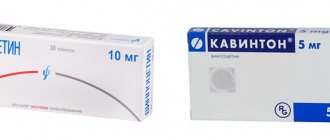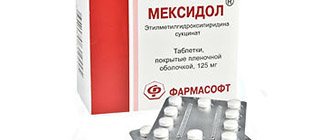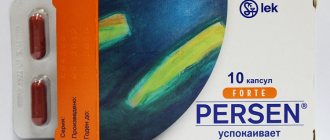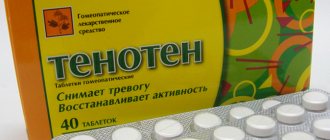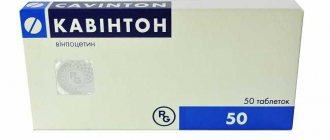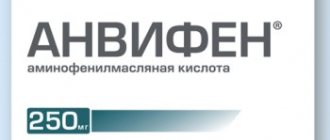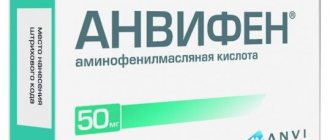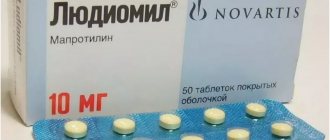The drug Mydocalm is intended for therapeutic purposes in neurology - it relieves pain syndromes, restores muscle tone, and normalizes trophism. It has a local anesthetic effect and membrane-stabilizing properties. By dilating blood vessels, it accelerates blood circulation and lymph outflow. Reduces tension in the musculoskeletal system.
Release form and composition
The product is available in 2 forms - tablets and injections. The main active ingredient is tolperisone hydrochloride, contained in volumes of 50 mg, 150 mg, 1 ml. The solution has a transparent color and a specific odor. Packaged in sterile ampoules with a capacity of 1 ml. One package contains 5 units.
Tablets are round, biconvex, white, with digital engraving on one side. The smell is characteristic, but weak. There are 2 types available - 50 and 150 mg of active ingredient, each package contains 30 pieces.
Composition of tablets (internal filling):
| Tolperisone dosage (mg) | Citric acid monohydrate | Colloidal silicon dioxide | Stearic acid | Talc | Microcrystalline cellulose | Corn starch | Lactose monohydrate |
| 50 | 0,73 | 0,8 | 1,7 | 4,5 | 14 | 29,77 | 48,5 |
| 150 | 2,19 | 2,4 | 5,1 | 13,5 | 42 | 89,31 | 145,5 |
The shell contains the following (at 50 mg and 150 mg respectively):
- colloidal silicon dioxide - 0.045/0.089 mg;
- titanium dioxide - 0.244/0.487 mg;
- lactose monohydrate - 0.392/0.785 mg;
- hypromellose - 3.927/7.854 mg.
The 150 mg tablets additionally contain macrogol 6000 in the amount of 0.785 mg.
Auxiliary composition of the injection solution:
- lidocaine hydrochloride - 2.5 mg;
- E218 (methyl parahydroxybenzoate);
- Diethylene glycol monoethyl ether.
Dosage form
Mydocalm is a Hungarian medicine intended to relieve muscle spasms and restore metabolism.
Sold in tablet form, as well as in the form of a solution for injections, sealed in ampoules.
The tablets contain 50 or 150 mg of the active substance - tolperisone. One package includes 30 tablets.
One ampoule contains 1 ml of a medicinal solution, including 100 mg of the active ingredient, and another 2.5 mg of lidocaine, an anesthetic. One package contains 5 ampoules.
pharmachologic effect
Mydocalm belongs to the pharmacotherapeutic group of centrally acting muscle relaxants. ATX encoding - M03BX04.
Pharmacodynamics
The mechanism of action is not fully understood. The therapeutic benefit of the active substance is achieved through an inhibitory effect on the spinal reflex pathways and an inhibitory effect on the descending pathways. The drug inhibits voltage-gated calcium channels and inhibits the activity of sodium channels, thereby eliminating the negative effect. During the secondary action, the path for calcium ions to enter the synapses is blocked, which leads to blocking the process of transmitter removal.
Pharmacodynamic properties:
- membrane stabilizing effect;
- decreased electrical excitability in afferent fibers and motor neurons;
- acceleration of peripheral blood circulation;
- pain relief;
- antiadrenergic effect;
- high degree of affinity for nerve tissues, due to which the substance is concentrated in the brain stem and spinal cord.
Pharmacokinetics
Pharmacokinetic properties of the tablet form
After oral administration, the substances are quickly absorbed and distributed throughout the body from the gastrointestinal tract, concentrating in maximum quantities after 30-60 minutes. Pronounced first pass metabolism ensures bioavailability of up to 20%. To increase the percentage of bioavailability, it is necessary to take fatty foods, but at the same time the time of maximum concentration increases by 20-30 minutes. The substance is metabolized in the renal system and liver, so 99% is excreted through the urinary fluid. The half-life is 2 and a half hours.
Pharmacokinetics of injection solution
Liquid tolperisone, as in tablets, is metabolized in the liver and kidneys. Half-life occurs after an hour and a half. Lidocaine is completely adsorbed. If the drug is administered intravenously, the maximum concentration of the active substance in the blood plasma is observed after 30-40 minutes, the relationship with proteins is 60-80%.
The injection solution instantly spreads throughout the tissues, penetrates the placental (40%) and blood-brain protective barriers. Cleavage occurs due to dealkylating amino groups and microsomal enzymes that break the amide bond, forming active metabolites. 10% of the solution is excreted in urine, the rest in bile, but some is reabsorbed in the intestine.
Based on preclinical studies on toxicity and safety, it was found that the drug does not pose a threat to the reproductive system of the human body.
Indications for use of Mydocalm
Tablets and injections are prescribed for the following pathological conditions:
- hypertonicity of the skeletal muscles with damage to the central nervous system of an organic nature - stroke and diseases of the pyramidal tracts of the brain, multiple sclerosis, encephalomyelitis, etc.;
- cerebral palsy;
- contracture that occurs against the background of osteochondrosis, osteoarthrosis, spondylosis;
- stiffness of movement, impaired speech due to spasticity of skeletal muscle tissue;
- muscular dystonia;
- spinal dystrophy;
- inflammatory processes in the spinal cord and brain against the background of intoxication of the body, allergies and viral damage;
- after spinal cord injury and surgery;
- cervical and lumbar syndrome;
- arthrosis of large joints.
Mydocalm is prescribed in complex therapy as an adjuvant for the following pathologies:
- obliterating diseases of the circulatory system - thromboangiitis, diabetic angiopathy, arteriosclerosis, Raynaud's syndrome, diffuse scleroderma;
- pain during menstruation;
- cholelithiasis;
- haemorrhoids;
- colic in the kidneys;
- threat of miscarriage with high uterine tone;
- impaired vascular innervation - intermittent angioedema dysbasia, acrocyanosis;
- diffuse scleroderma with fibroids;
- complications of diabetes.
Tolperisone or Mydocalm – what to choose?
Tolperisone is a muscle relaxant that normalizes the condition of nerve fibers and relieves muscle spasms. The medication is based on an active substance with the same name. Sold only in tablet form, not available as a solution for injections.
Tolperisone is an analogue of Mydocalm in terms of its effect on the body. The drug is used for the following pathologies:
- muscle spasms of any origin;
- cerebral palsy, represented by spastic diplegia;
- spinal paralysis;
- epilepsy;
- muscle hypertonicity;
- intermittent angioedema;
- parkinsonism;
- acrocyanosis;
- obliterating atherosclerosis;
- encephalopathy.
Tolperisone should not be taken by children under 18 years of age, breastfeeding women, as well as patients with myasthenia gravis and intolerance to the components of the drug.
When taking Tolperisone, unpleasant side effects may occur:
- intense headaches;
- weakness;
- decreased blood pressure;
- allergic skin reaction.
Side effects of Mydocalm
Adverse reactions occur when the drug is taken incorrectly (often uncontrolled self-medication) and against the background of contraindications.
Negative effect of the tablets:
- a sharp decrease in blood pressure;
- nausea and vomiting;
- abdominal discomfort;
- headache;
- muscle weakness.
Side effects from injections:
- difficulty breathing;
- minor loss of coordination of movements caused by muscle weakness;
- heart failure.
In both cases, an allergic reaction is possible:
- skin rashes;
- itching;
- swelling;
- hives;
- shortness of breath and bronchospasm;
- Quincke's edema (affects the face and genitals);
- anaphylactic shock.
Methods of use and dosage Mydocalm
Tablet Mydocalm is taken orally. The dosage depends on the severity of the lesion, the individual characteristics of the body and the type of disease. The daily norm is divided into 3 equal doses. On average it is from 150 to 450 mg. At the initial stages, a minimum dose is prescribed. The tablets are taken after meals with water.
Dosage depending on age category:
- from 3 to 6 years: per 1 kg of weight 5 mg;
- from 6 to 14 years: per 1 kg of body weight from 2 to 4 mg;
- adolescents over 14 years of age and adults: at least 50 mg twice daily.
The injection solution is administered in different ways:
- Intravenously. Use 1 ml once a day.
- Intramuscularly. It is prescribed in a daily dosage of 200 mg (2 ml), divided into 2 times.
Instructions for use of Mydocalm
The optimal daily dose for an adult patient is 150 mg of the drug.
It is enough to take 1 tablet of 50 mg 3 times a day to get rid of spasms.
But if the spasmodic attacks are intense, the doctor may prescribe the patient a higher dose of medication.
Children are prescribed 1 tablet of 50 mg per day. The tablet can be divided into several doses. If it is difficult for a small child to swallow the medicine, the tablet can be ground into powder. The therapeutic course can last no more than 10 days.
Injections of the drug can be both intramuscular and intravenous.
Injections into the muscle are made twice a day, 100 mg of the drug. Injections into a vein are made once a day, 100 mg of the active substance.
It is impossible to plan a therapeutic course and dosage without consultation with a medical specialist. Only a doctor can prescribe the optimal course of treatment and effective daily dose.
Mydocalm is good because it can be taken without fear with any other medications. Also, the activity of the drug is not inhibited by alcohol, therefore, during treatment with a muscle relaxant, drinking alcoholic beverages is allowed.
Interaction
It is known that tolperisone has an effect on the central nervous system, but despite this there is no sedative reaction. Therefore, there are no restrictions on the use of Mydocalm:
- a muscle relaxant goes well with sedatives;
- used with sleeping pills;
- enhances the effect of antihypertensive medications based on clonidine;
- used with anesthetic agents;
- prescribed along with psychotropic groups;
- interacts with muscle relaxants.
Most often, Mydocalm is combined in one treatment regimen with Milgamma and Movalis for pathological disorders of the musculoskeletal system. This allows you to significantly reduce the pain threshold, relieve spasms, and restore muscle tone. In addition, it has a neuroprotective effect, which eliminates inflammatory processes and stops the degenerative development of diseases.
Mydocalm during pregnancy and lactation
Mydocalm in tablets and injections is prohibited for use by children under 3 years of age. Accordingly, it is not recommended to take the drug during pregnancy. The medicine does not have a teratogenic effect, however, studies have not been conducted on women during pregnancy and breastfeeding. Based on this, tablets or injections can be prescribed, but in minimal daily dosages - mainly in cases where it is vital for the mother. You will have to stop breastfeeding your baby.
Analogues of Mydocalm
Analogues are drugs that have the same pharmacological effect. The products may contain a similar or different active substance and act on the body through the same or a different mechanism. Mydocalm has a sufficient number of analogues. Therefore, it is worth understanding in more detail which of the presented remedies is better or worse than Mydocalm.
Which is better: Sirdalud or Mydocalm?
What do the drugs have in common:
- Both are muscle relaxants, but have different compositions.
- The mechanism of action is the same - nerve impulses are blocked.
- General indications are problems with the musculoskeletal system.
- There is no big difference in cost.
What is the difference:
- Sirdalud is based on tisinidine, which acts on presynoptic alpha-2 receptors in the spinal cord. This leads to the transmission of excitation polysynaptically and blocking of interneurons. Mydocalm consists of tolperisone, which inhibits increased excitability by regulating the functionality of the reticular formation in the caudal zone, and also affects peripheral nerve endings.
- The first drug is concentrated in maximum quantities after 60 minutes, the second - 30.
- Sirdalud is produced only in the form of tablets, Mydocalm is also available in an injection solution.
- Sirdalud provokes dangerous disorders in the liver, which is why the patient must monitor the functionality of the liver tissue (conduct an examination).
- Mydocalm has fewer adverse reactions. For example, the concentration of attention does not decrease, the pulse does not slow down, the mucous membranes do not dry out, powerlessness is not felt, and the activity of the gastrointestinal tract is not disrupted.
Which is better: Tolisor or Mydocalm?
Both drugs are based on tolperisone, so the mechanism of action is similar. But there are differences between them:
- Mydocalm loses its therapeutic effect much faster. The result is noticeable after three days of use.
- Tolisor has more side effects because it has not passed all clinical trials.
- Although the two remedies act identically, there are still differences. Mydocalm has a central effect, while Tolisor affects individual parts of the brain. At the same time, the anesthetic effect is slightly lower and there is no effect on the overall functioning of the central nervous system.
- Mydocalm, if necessary, is allowed for use during pregnancy; Tolisor is strictly prohibited.
Thus, Mydocalm is an original drug that has passed all stages of clinical trials and is considered safe.
Which is better: Movalis or Mydocalm?
The main active ingredient in Movalis is meloxicam. The drug belongs to the anti-inflammatory group, and not to muscle relaxants. Based on this, comparing the two means is meaningless. However, both Movalis and Mydocalm cope well with pain syndromes in the musculoskeletal system. Only the first, in addition to pain relief, relieves inflammation, and the second relieves pain and restores muscle tone.
Being a non-steroidal drug, Movalis suppresses the activity of COX-1 and 2, and Mydocalm suppresses the excitability of nerve cells. Quite often, drugs are prescribed in one therapeutic regimen, as they combine well with each other, enhancing each other’s effects. In this case, the doctor must select an individual dosage depending on the indications.
Which is better: Tolperisone or Mydocalm?
Mydocalm and Tolperisone are completely identical, since they contain the same active substance. Medicines are produced in the same proportions - 50 mg, 150 mg (in tablet form). Tolperisone - in the form of dragees, Mydocalm - tablets, injection solution. In terms of speed of action, the second is considered faster; general weakness is not noted as a side reaction. Tolperisone should not be taken until the age of 18, and Mydocalm is prescribed from the age of 3. The cost of the latter is lower (on average 100-150 rubles). It is impossible to determine which of them is better, since the level of therapeutic effect largely depends on the specific characteristics of the body.
Which is better: Meloxicam or Mydocalm?
Meloxicam belongs to the group of non-steroidal anti-inflammatory drugs that are aimed at relieving pain and inflammation in the musculoskeletal system. Mydocalm is a muscle relaxant that eliminates pain and restores muscle tone. Consequently, the drugs have different purposes, but are actively used together. However, Meloxicam is prescribed for the same pathologies as Mydocalm (osteochondrosis, arthrosis). Despite the fact that the drugs are different, they are similar for relieving pain. What exactly to take should be decided by the attending physician, based on the cause of the pain.
Which is better: Mexidol or Mydocalm?
Mexidol's active substance is ethylmethylhydroxypyridine succinate, and Mydocalm's is tolperisone. But the drugs have similarities in the composition of the auxiliary components - talc, titanium dioxide, lactose monohydrate (tablet form). Medicines are aimed at eliminating neurological problems:
- reducing the level of muscle spasms;
- pain relief.
This allows the use of drugs to treat the same diseases: spondylosis, arthrosis, contracture, muscle hypertonicity, injuries, osteochondrosis, etc. The mechanism of influence on the body is almost equivalent, so the drugs are interchangeable. However, Mexidol additionally has a nootropic anxiolytic effect. Moreover, it is advisable to use them together as complementary agents.
Which is better: Baclofen or Mydocalm?
Medicines belong to one group - centrally acting muscle relaxants. Mydocalm contains tolperisone, Baclofen contains baclofen. General indications:
- high muscle tone;
- spinal injuries;
- impaired cerebral circulation;
- cerebral palsy;
- diseases affecting the muscular system of the back;
- spinal cord pathologies;
- motor neuron dysfunction.
Baclofen is additionally used for cerebral palsy, withdrawal and affective states against the background of alcoholism and drug addiction. The drugs have some side effects, but Baclofen has more contraindications: the age at which it can be taken is 12 years, atherosclerosis, cerebrovascular insufficiency. Baclofen should be taken with extreme caution, as the slightest overdose can cause cardiac and respiratory arrest.
Which is better: Tizanidine or Mydocalm?
Tizanidine is based on the active substance of the same name and is part of the group of centrally acting muscle relaxants. The mechanism is to stimulate presynaptic alpha-2 adrenergic receptors, due to which transmitter amino acids are suppressed, which restores the tonic state of skeletal muscles. This indicates that Tizanidine acts on the body in the same way as Mydocalm, but taking the drug is allowed only from the age of 18 (Mydocalm - from 3 years). The choice is influenced by the type of disease, the individual characteristics of the patient’s body, the severity of the disease and the age category.
Mydocalm analogues are cheaper (list with prices)
Mydocalm is a popular drug. It is one of the most commonly purchased muscle relaxants. However, pharmacies sell a large number of analogues that cost less than Mydocalm. Substitutes in composition and principle of action, produced by different manufacturers, cost 200 - 500 rubles, and have several forms of release.
Below are listed analogues cheaper than Mydocalm, available in injections and tablets:
- Tolperisone – 280 rubles;
- Sirdalud – 340 rubles;
- Baklosan – 370 rubles;
- Baclofen – 380 rubles;
- Miolgin – 230 rubles;
- Texamen – 240 rubles;
- Vitaxon – 190 rubles;
- Trigamma – 145 rubles;
- Meloxicam – 155 rubles;
- Calmirex – 450 rubles.
Mydocalm for osteochondrosis
With osteochondrosis of any part of the spine, muscle tension is noted and spastic pain appears. To eliminate such signs, it is customary to prescribe centrally acting muscle relaxants (the central parts of the nervous system regulate muscle tone). Therefore, Mydocalm is prescribed quite often.
Advantages of using Mydocalm for osteochondrosis syndrome:
- The muscle relaxant effect of the drug is selective. Namely: excitability in muscle fibers decreases, but nerve impulses are not suppressed. This makes it possible to maintain muscle strength during movements, so that posture remains unchanged.
- Mydocalm can be used for a long period, since the tolerability of the active substance is high (no addiction, no new adverse reactions appear).
- There are no effects of mental and physical inhibition. The person continues to engage in usual activities, does not lose ability to work, and does not become sleepy.
- Tolperisone interacts with many drugs that are intended to treat osteochondrosis.
- Anesthetic properties make it possible to reduce the dosage of nonsteroids.
Mydocalm for headaches
A headache causes a lot of unpleasant sensations, so every person tries to stop it as quickly as possible. To do this, people take analgesics, non-steroidal anti-inflammatory drugs, and other things that are intended for pain relief. Undoubtedly, there is a certain effect: the pain syndrome is reduced for a while. But the cause of the pain is not eliminated. Mydocalm, being a powerful muscle relaxant, shows excellent results in the fight against headaches, as it has relaxing properties.
Unfortunately, it is not always possible to achieve the desired effect with the help of a muscle relaxant. This phenomenon is associated with the cause of pain in the brain. It turns out that the main indication is tension and spasm. This can be spasm of the muscular system, squeezing of blood vessels, pinching of nerves, which is why tension appears.
The fact is that muscle strain contributes to vasoconstriction and slows down the blood supply process (ischemia), which negatively affects nutritional functions. Thus, beneficial substances do not reach the muscles, and stagnation occurs. Mydocalm dilates blood vessels, which accelerates blood circulation and nourishes muscle fibers. At the same time, the anesthetic effect relieves spasms.
Problems for which it is advisable to take Mydocalm (in the presence of headaches):
- osteochondrosis of the cervical spine;
- migraine;
- spinal automaticity;
- multiple sclerosis;
- neurological diseases;
- cerebral palsy;
- encephalopathy.
Sirdalud or Mydocalm - which is better?
If the question arises of what to replace Mydocalm with, then the most popular analogue is the Swiss drug Sirdalud.
This medication is similar to Mydocalm not in the active substance, but in the principle of its effect on the body.
The active component of Sirdalud is tizanidine. The medicine is sold in tablet form, one tablet contains 2 or 4 mg of tizanidine.
The Swiss analogue has a significant advantage over the original drug. Tizanidine, once in the human body, is not absorbed from the tablet immediately, but gradually, so that the medicine acts evenly throughout the day.
The main effect of tizanidine is inhibition of the transmission of nervous excitation, leading to a weakening of muscle tension. Sirdalud is not only a muscle relaxant, but also an analgesic of moderate activity. The medicine begins to act an hour after administration. The spent active substance leaves the body in 3–4 hours.
Sirdalud is prescribed for the following pathologies:
- osteochondrosis and other diseases of the spinal column, complicated by painful spasms of the spinal muscles;
- pathological changes in bone and joint tissue;
- multiple sclerosis;
- stroke;
- convulsive states of any origin;
- cerebral palsy;
- some diseases of the spinal cord;
- negative consequences of spinal surgery.
It is forbidden to take the medication if:
- liver dysfunction;
- intolerance to the active substance;
- treatment with antidepressants, fluoroquinolone antibiotics, CYP1A2 inhibitors;
- feeding a child with breast milk.
The effect of a muscle relaxant on a developing embryo in the womb has not been studied. Therefore, it is not advisable to take the medicine during pregnancy. Doctors prescribe Sirdalud to pregnant patients only as a last resort, when the need for recovery is more important than the likely risk to the fetus.
Sirdalud gives more side effects than Mydocalm. When taking Swiss medication, the following unpleasant phenomena are possible:
- weakness, powerlessness;
- liver dysfunction;
- nausea;
- drying of the oral mucosa;
- disruption of the digestive tract;
- decreased blood pressure;
- slowing heart rate.
Taking Sirdalud can provoke serious pathological changes in the functioning of the liver. Therefore, during therapy, it is recommended to periodically undergo laboratory tests to check the condition of the liver tissue. The drug also has a negative effect on concentration.
Overdose is accompanied by the following symptoms:
- significant decrease in blood pressure;
- nausea;
- weakness, malaise;
- dizziness;
- respiratory dysfunction.
In case of severe overdose, the patient may fall into a coma.
- Calcium is an important substance for the human body;
- Cheap analogue of Xarelto - list of medications;
- - analogues of Lamisil.
Mydocalm for intercostal neuralgia
In some diseases of the spinal column, the intercostal nerves are compressed, causing intercostal neuralgia syndrome to occur. In this case, the patient experiences severe pain that limits movement. To suppress it, various drugs are prescribed - non-steroidal anti-inflammatory drugs, antispasmodics. But all of them only relieve pain and reduce the inflammatory process, so muscle relaxants, in particular Mydocalm, become the best treatment option.
With intercostal neuralgia due to pinched nerve endings, the muscular system of the back begins to reflexively contract, which significantly increases its tone. Against this background, a spasm of blood vessels develops, which leads to the accumulation of lactic acid in the tissues. This waste product has a toxic effect, which increases pain. This is how pain occurs between the ribs.
Mydocalm is aimed at eliminating vasospasm, reducing muscle tone, thereby breaking the “vicious circle” of ongoing processes. Therefore, the drug not only relieves discomfort, but also has a therapeutic effect, that is, it eliminates the cause of the pain syndrome.
In case of a neuralgic condition, Mydocalm is best used as an injection, but this depends on the strength of the pain threshold and the degree of neglect of the pathology. How to use the product correctly:
- in the first days (from 5 to 10) Mydocalm is administered intramuscularly twice a day;
- then the same drug is prescribed in tablet form.
The duration of therapy is determined by the attending physician.
Meloxicam or Mydocalm – what to buy?
Meloxicam is a non-hormonal anesthetic and anti-inflammatory agent based on the active substance of the same name.
It is considered an analogue of Mydocalm based on the principle of its effect on the body.
Sold in tablet form, as well as in the form of suppositories and solution for injections. If you choose analogs in ampoules that are cheaper than Mydocalm, then Meloxicam is a good option.
Meloxicam is prescribed for the following pathologies:
- arthritis;
- osteochondrosis;
- inflammation of joint tissue;
- Bekhterev's disease.
Do not use the medicine if:
- intolerance to the active component;
- kidney dysfunction;
- peptic ulcer;
- bronchial asthma;
- polyps in the nasal cavity;
- pregnancy and lactation.
It should be noted that doctors often prescribe Meloxicam and Mydocalm to patients in combination for the treatment of certain diseases. Although the drugs are analogues of each other, their combined use does not provoke an increase in side effects.
